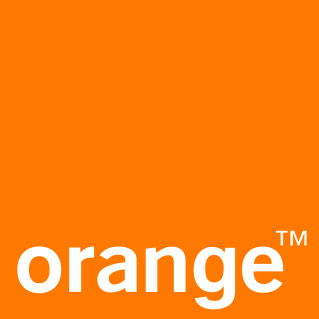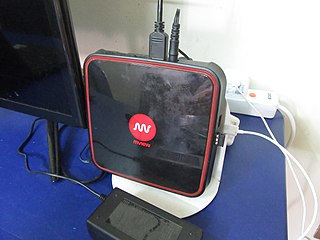Telecommunications in Moldova are maintained at a relatively high performance level. Because Moldova is a small country, telecommunications companies managed to achieve good coverage in both wired and wireless communications infrastructure. Landline is available in most settlements, however mobile phone popularity has vastly increased in recent years. Mobile communications infrastructure are fairly well developed but suffer from high prices, nonetheless the amount of mobile subscriptions is growing very fast compared to the landline. As far as the Internet is concerned, Moldova has one of the best wired Internet connections in the world as well as one of the cheapest in $ per Mbit.
Telecommunications in Mongolia face unique challenges. As the least densely populated country in the world, with a significant portion of the population living a nomadic lifestyle, it has been difficult for many traditional information and communication technology (ICT) companies to make headway into Mongolian society. With almost half the population clustered in the capital of Ulaanbaatar, most landline technologies are deployed there. Wireless technologies have had greater success in rural areas.

The telecommunication infrastructure of Singapore spans the entire city-state. Its development level is high, with close accessibility to the infrastructure from nearly all inhabited parts of the island and for all of the population, with exceptions. Today, the country is considered an international telecommunications hub, an achievement that was driven by Singapore's view that high-quality telecommunications is one of the critical factors that support its economic growth.

Orange S.A., formerly France Télécom S.A. stylized as: france telecom, is a French multinational telecommunications corporation. It has 266 million customers worldwide and employs 89,000 people in France, and 59,000 elsewhere. It is the tenth largest mobile network operator in the world and the fourth largest in Europe after Vodafone, Telefónica and VEON. In 2015, the group had revenue of €40 billion. The company's head office is located in the 15th arrondissement of Paris. The current CEO is Stéphane Richard. The company is a component of the Euro Stoxx 50 stock market index.

Digital Video Broadcasting (DVB) is a set of international open standards for digital television. DVB standards are maintained by the DVB Project, an international industry consortium, and are published by a Joint Technical Committee (JTC) of the European Telecommunications Standards Institute (ETSI), European Committee for Electrotechnical Standardization (CENELEC) and European Broadcasting Union (EBU).

Streaming television is the digital distribution of television content, such as TV shows, as streaming media delivered over the Internet. Streaming TV stands in contrast to dedicated terrestrial television delivered by over-the-air aerial systems, cable television, and/or satellite television systems. The use of streaming online video and web television by consumers has seen a dramatic increase ever since the launch of online video platforms such as YouTube and Netflix.

Internet Protocol television (IPTV) is the delivery of television content over Internet Protocol (IP) networks. This is in contrast to delivery through traditional terrestrial, satellite, and cable television formats. Unlike downloaded media, IPTV offers the ability to stream the source media continuously. As a result, a client media player can begin playing the content almost immediately. This is known as streaming media.
Malaysian television broadcasting was introduced on 28 December 1963. Colour television was introduced on 28 December 1978. Full-time colour transmissions were officially inaugurated on New Year's Day 1982. There are currently 8 national free-to-air terrestrial television stations in Malaysia and 2 national pay subscription television stations in Malaysia.

Sky Angel was a U.S. operator of Christian television networks; it operated three channels, Angel One, Angel Two, and KTV, all of which were exclusive to Dish Network. The company's corporate headquarters were located in Naples, Florida. The company also operated a Chattanooga, Tennessee location where programming, engineering and network operations resided.
Zattoo is a TV platform for IP-based transmission of television channels and video on demand content to a variety of devices. The company headquarters are located in Zurich and it has an additional office in Berlin. Zattoo is operational in two business areas - in addition to its own B2C TV streaming operations aimed at end customers in countries such as Germany and Switzerland, Zattoo has a B2B offering and works with telecommunication companies worldwide.
Digi Communications, also known as RCS & RDS, is a Romanian telecommunication holding company operating in Romania, Hungary, Spain and Italy. Digi was founded by Zoltán Teszári, who is the majority owner, and it is listed on the Bucharest Stock Exchange since 16 May 2017.

Livestation was a platform for distributing live television and radio broadcasts over a data network. It was originally developed by Skinkers Ltd. and is now an independent company called Livestation Ltd. The service was originally based on peer-to-peer technology acquired from Microsoft Research. Between mid-June 2013 and mid-July Livestation was unavailable to some subscribers due to technical issues.
In Malaysia, digital television broadcasts, DTV or DHD, can be received via cable, internet, satellite, or via free over-the-air (OTA) digital terrestrial television - much like analogue television broadcasts have been. It began in the mid-1990s with the introduction of the Astro satellite television service, now followed by new paid television services in the 2000s, as well as the digitalisation of over-the-air TV which was expected to be complete by the mid-2010s before being shelved. This article discusses various platforms where DTV is applied in Malaysia, including Digital Video Broadcasting (DVB) and Internet Protocol Television (IPTV). Following its successful nationwide digital transition on 31 October 2019, the country became the third in Southeast Asia with digital broadcasts after neighbouring Brunei and Singapore.
Television in Romania started in August 1955. State television started to broadcast on December 31, 1956. The second television channel followed in 1968, but between 1985 and 1990, there was only one Romanian channel before the return of the second channel. Private broadcasters arrived in December 1991, with SOTI which was the first private nationwide television station in Central and Eastern Europe. Romania has the highest penetration rates for pay television in the world, with over 98% of all households watching television through cable or satellite.

UPC is the largest cable operator in Switzerland with around 1.1 million residential and business customers and was formed in 1994 through the merger of several cable operators.

Internet television in Australia is the digital distribution of movies and television content via the Internet. In Australia, internet television is provided by a number of generalist, subscription-based streaming service providers, in addition to several niche providers that focus on specific genres. Australia's five major free-to-air television networks also all offer catch up TV of previously broadcast content to watch via their webpages and apps, and a number of ISPs and other companies offer IPTV – the live streaming of television channels sourced from Australia and elsewhere.
VMedia Inc. is a Canadian telecommunications company and broadcast distribution provider. It offers VoIP telephone and home security services across Canada; DSL and cable Internet in Ontario, Quebec, Manitoba, Saskatchewan, Alberta, and British Columbia; and IPTV television service in Ontario, Quebec, Alberta and British Columbia.
An over-the-top is a streaming media service offered directly to viewers via the Internet. OTT bypasses cable, broadcast, and satellite television platforms, the companies that traditionally act as a controller or distributor of such content. It has also been used to describe no-carrier cellphones, where all communications are charged as data, avoiding monopolistic competition, or apps for phones that transmit data in this manner, including both those that replace other call methods and those that update software.

Fetch TV is an Australian IPTV provider that delivers a subscription television service over a user's regular internet service. Fetch TV launched in 2010 backed by its Malaysian parent Astro All Asia Networks, which owns 75% in the company.
The distribution of cable television around the world:










